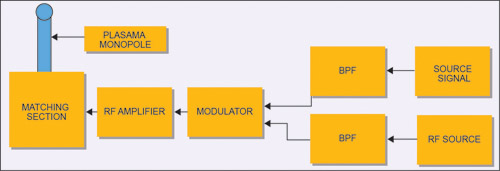(ii) Non-thermal plasma. Here ions and neutral particles are at lower temperature as compared to electrons, or we can say that the electrons are somewhat ‘hotter’ than ions. This fits for the antenna system application.
Fluorescent lamps and neon signs are examples of plasma states. In case of lamps, the extra electrons added at the electrode ionises the gas with the help of mercury atoms and the result is ionised state of plasma.
The most common way of generating a low-temperature plasma is by applying electric field to a neutral gas. The neutral gas always contains a few electrons and ions. When an electric field is applied to it, these free carriers are accelerated and they collide with atoms and molecules. This is similar to an avalanche breakdown, that is, a large number of charge carriers are formed at the loss of old carriers, and so there is a balance in carrier generation. In this way, steady-state plasma is developed.
Consider DC discharge system for a rough idea. If we subject the gas to high pressure, there would be a high-collision rate and this could produce thermal plasma. But DC discharge system requires non-thermal plasma, so we will pressurise the gas at low pressure to produce a low-collision rate. A high electric field is applied to the electrode plates and the phenomena stated above takes place. Following this pattern, if we apply more voltage, we will get more plasma density. But if we apply electric current in microsecond pulses, we can obtain high plasma density at the same input power. This can be advantageous as the voltage requirements of the system are determined by the nature of gas, electrode material, current density and length of the tube.
Earlier, the DC discharge systems were very bulky but now engineers have been able to reduce their size. but the ionisation instrument is still bulky and hence it limits its universal application.
Interaction of plasma with EM waves
As we are interested in designing antenna systems, the interaction and behaviour of plasma with EM waves must be investigated for better understanding. As per some theses, various relations are set up (qualitatively) to study their interaction. Plasma contains quasi-neutral particles, which means they are highly conductive. For analysing interaction with EM waves, four important parameters are conductivity, electrical permittivity, magnetic permittivity and propagation constant.
Qualitatively, the interaction of plasma with EM waves can be formulated as:
1. Plasma with high-collision frequency behaves as a lossy medium. This is due to the reason that with increase in plasma pressure and electron density, the rate of collision increases, so considerable amount of energy will be lost. (This is the reason why thermal plasma is unfit to be used in antennae.)
2. If W > Wp. EM wave frequency is greater than plasma frequency (an inherent property of plasma), so wave propagates in plasma and the plasma has dielectric properties which are electrically controllable.
3. If W < Wp. The propagation constant is imaginary. The wave is vanishing with the plasma medium. The wave can be absorbed or reflected depending on the collision frequency.
4. Effect of magnetic field. The plasma can be shaped into specific geometry to match the needs of intended application. This is done by applying magnetic field which will make a cyclic motion of the charged particle. This is also an important property as it frees the traditional image of antennae in our mind, although geometries are limited.
The plasma antenna
antenna is a matching section between two output terminals of a transmitter and space, or between space and two input terminals of a receiver. Radiation is simply the transfer of energy through a medium. So a plasma antenna is a type of transmission and reception device that makes use of plasma medium rather than metal components.

The electron behaviour of plasma antenna is completely different from that of metal antenna. In the plasma antenna, the functioning concept is altogether different. It is due to ‘electrons in free space’ rather than ‘electrons moving freely.’ The design allows for extremely short pulses that are very important to many forms of digital communication and radars.
One fundamental distinguishing feature of a plasma antenna is that the gas ionising process can manipulate resistance. When de-ionised, it has infinite resistance and hence it does not react with RF. when ionised, it will have some resistance due to which it will react with EM waves.







Thank you very much…. your article is so easy to understand and explained in a simple … i am happy bcoz now i am familiar with plasma antenna… you are a good author…. thank you again
You are most welcome.
excelente. aprendi mucho con su articulo
Gracias por tus comentarios.